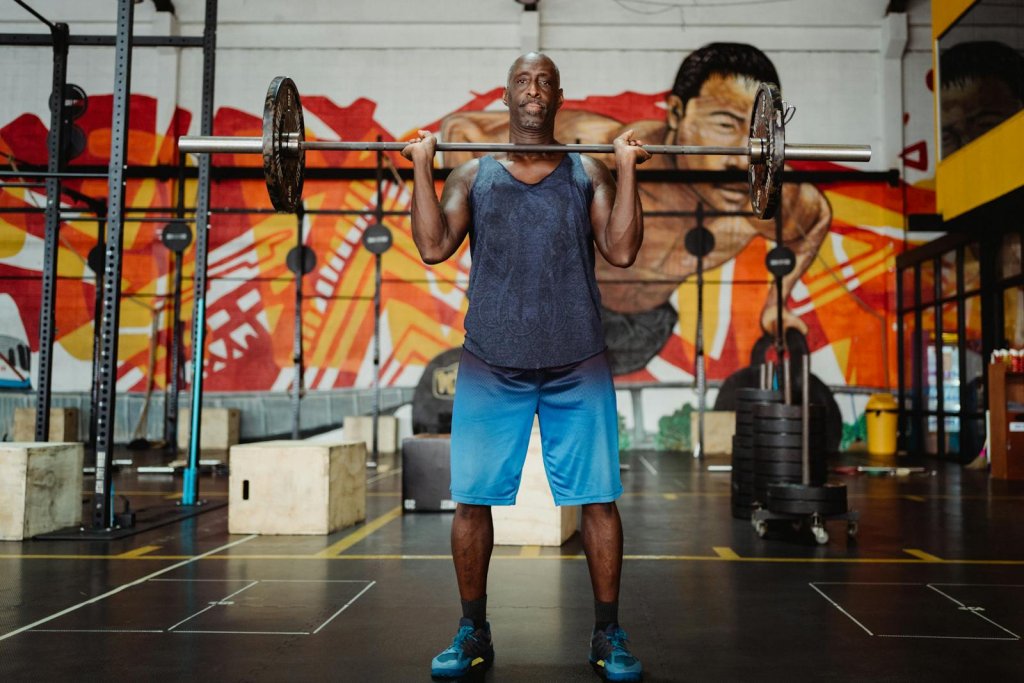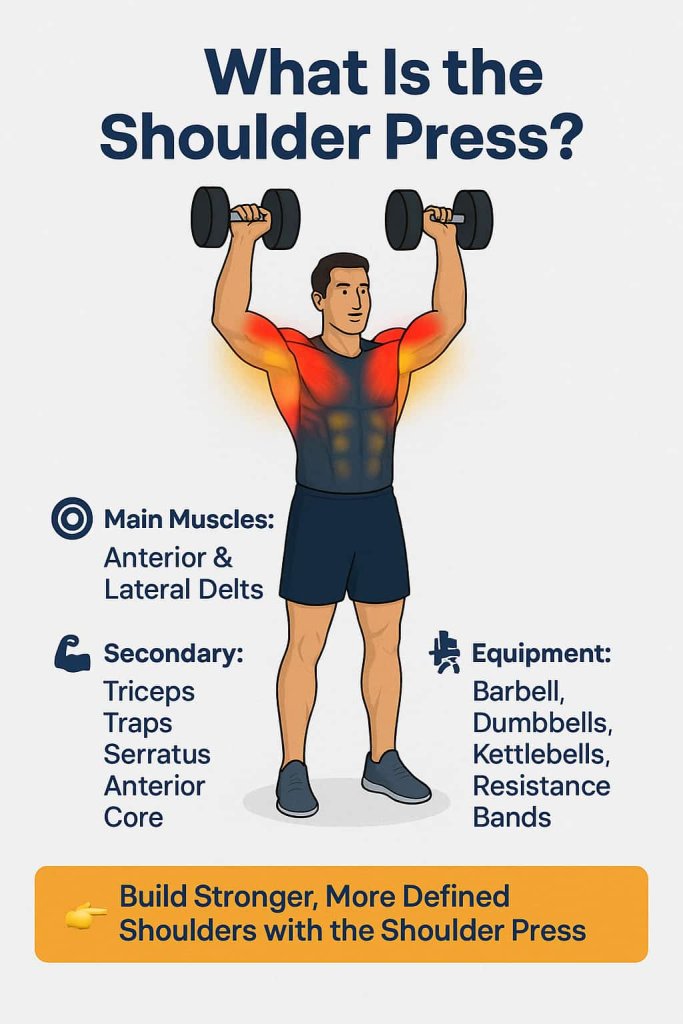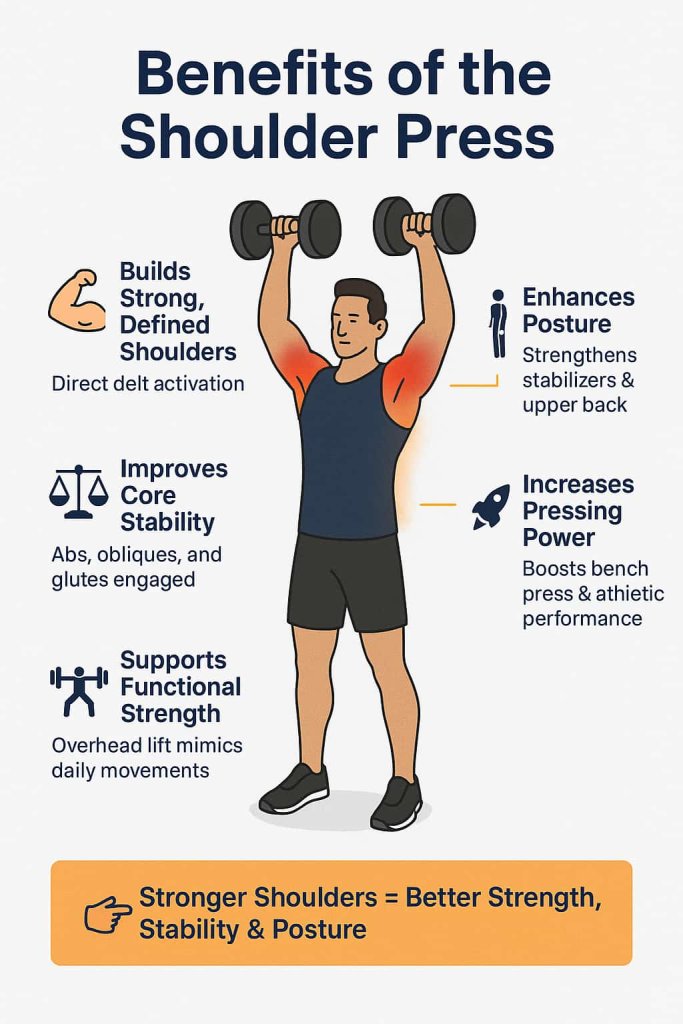The shoulder press is one of the best exercises to build stronger, more defined delts—but only if done with proper form to avoid injury. This compound lift works your shoulders, triceps, traps, and core, making it a must-have for upper-body strength.

In this guide, you’ll learn the benefits of the shoulder press, step-by-step instructions, common mistakes to avoid, variations for all levels, and injury-prevention tips. Whether you’re a beginner or an experienced lifter, this breakdown will help you press smarter and safer.
What Is the Shoulder Press?
The shoulder press—also called the overhead press or military press—is a movement where you press a barbell, dumbbells, or kettlebells overhead. It primarily targets the deltoid muscles (front and side heads), while also engaging the triceps, traps, serratus anterior, and core stabilizers.

- Main muscles worked: anterior and lateral deltoids
- Secondary muscles: triceps, traps, serratus anterior, core
- Equipment: barbell, dumbbells, kettlebells, or resistance bands
Benefits of the Shoulder Press

- Builds Strong, Defined Shoulders – Directly targets deltoids for size and strength
- Improves Core Stability – Standing presses train abs, obliques, and glutes
- Supports Functional Strength – Overhead pressing mimics everyday movements
- Enhances Posture – Strengthens stabilizers and upper back
- Increases Pressing Power – Transfers strength to bench press and sports performance
How to Do the Shoulder Press (Step by Step)
1. Setup
- Stand with feet shoulder-width apart (for standing version)
- Hold the bar or dumbbells just outside shoulder width
- Palms forward, wrists straight, elbows slightly in front
2. Brace
- Engage your core and squeeze glutes to protect the spine
- Keep ribs down, chest tall, spine neutral
3. Press
- Press weights straight up as you exhale
- Move your head slightly back as the bar passes, then forward at the top
- End with arms extended overhead, biceps in line with ears
4. Lower
- Slowly lower the weight back under control
- Keep elbows under wrists, not flared wide
Common Mistakes to Avoid
| Mistake | Why It’s Risky | Fix |
|---|---|---|
| Elbows flared out at 90° | Stresses shoulder joint & rotator cuff | Keep elbows slightly forward |
| Overarching lower back | Hyperextension strains lumbar spine | Brace core, squeeze glutes, use lighter weight |
| Bar drifting forward | Poor leverage, impingement risk | Press straight up, head slightly back |
| Snapping elbows at lockout | Overloads joints | Extend fully but don’t slam lockout |
| Skipping warm-up | Higher risk of strain | Do mobility drills & warm-up sets |
Variations of the Shoulder Press
1. Standing Barbell Overhead Press
Why it works: Builds overall strength and power, engaging shoulders, triceps, and the entire core for stability.
Muscles worked: Deltoids (front & side), triceps, traps, core stabilizers.
How to do it:
- Stand with feet shoulder-width apart.
- Grip the barbell at shoulder height, palms facing forward.
- Brace your core and squeeze glutes.
- Press the bar directly overhead until arms are fully extended.
- Lower slowly back to shoulder level.
Trainer Tip: Keep ribs tucked to avoid over-arching your back.
2. Seated Dumbbell Press
Why it works: Isolates the shoulders by removing leg drive and reducing lower-back strain.
Muscles worked: Deltoids (front & side), triceps.
How to do it:
- Sit on a bench with back support.
- Hold dumbbells at shoulder height, palms facing forward.
- Keep elbows slightly in front of your torso.
- Press the dumbbells overhead until arms are straight.
- Lower slowly under control.
Trainer Tip: Don’t lock your elbows hard at the top—keep slight tension.
3. Neutral Grip Dumbbell Press
Why it works: A joint-friendly alternative that reduces shoulder stress while strengthening the delts and triceps.
Muscles worked: Front delts, triceps, serratus anterior.
How to do it:
- Sit or stand holding dumbbells at shoulder height, palms facing each other.
- Keep your wrists neutral (straight).
- Press straight overhead while keeping the dumbbells close to your head.
- Lower slowly to the start position.
Trainer Tip: Maintain core tightness—don’t lean back to push the weight.
4. Arnold Press
Why it works: Increases range of motion and activates all three heads of the deltoid.
Muscles worked: Front, side, and rear delts; triceps.
How to do it:
- Start seated or standing with dumbbells at chest level, palms facing you.
- Begin pressing upward while rotating wrists outward.
- Finish with palms facing forward at the top.
- Reverse the rotation as you lower back to the start.
Trainer Tip: Use controlled motion—avoid swinging or rushing the rotation.
5. Landmine Press
Why it works: Safer pressing variation for beginners or those with limited shoulder mobility. The angled path reduces stress on the joints.
Muscles worked: Shoulders, upper chest, triceps, core.
How to do it:
- Place one end of a barbell in a landmine base or corner.
- Stand with feet staggered for balance.
- Hold the bar with one hand at shoulder height.
- Press the bar upward and forward in an arc until your arm extends.
- Lower under control back to shoulder level.
Trainer Tip: Keep your torso upright—don’t lean excessively into the press.
Injury Prevention Tips
- Warm up with dynamic stretches (arm circles, band pull-aparts, wall slides)
- Strengthen rotator cuff (face pulls, external rotations)
- Train scapular stability (scap push-ups, YTWs)
- Start light, increase weight gradually
- Don’t press through pain; use landmine press if mobility is limited
Programming: Sets & Reps
- Strength: 4–6 sets of 4–6 reps, heavy weight, long rest
- Hypertrophy: 3–4 sets of 8–12 reps, moderate weight
- Endurance/Stability: 2–3 sets of 12–15 reps, light weight, controlled form
FAQs About the Shoulder Press
1. Is the shoulder press safe for beginners?
Yes, as long as you start light and focus on proper form. Seated dumbbell presses are beginner-friendly.
2. Should I do it standing or seated?
Standing builds more core stability; seated isolates shoulders. Both work depending on your goal.
3. Is the behind-the-neck press safe?
Not recommended—it increases shoulder impingement risk. Stick with front presses.
4. How often should I shoulder press?
Two to three times per week, with at least 48 hours rest between sessions.
5. What if I feel pain?
Stop immediately, check form, and consider mobility work or a variation like the landmine press.
6. Can lateral raises replace shoulder press?
No. Lateral raises target side delts but don’t build pressing strength. Use both for balance.
Conclusion
The shoulder press is one of the most effective moves for building strong, defined delts and better posture. Done correctly, it also improves functional strength and core stability. Avoid common mistakes, choose the variation that fits your mobility, and progress slowly to stay injury-free.
👉 Add the shoulder press to your workouts for stronger, more balanced shoulders.
